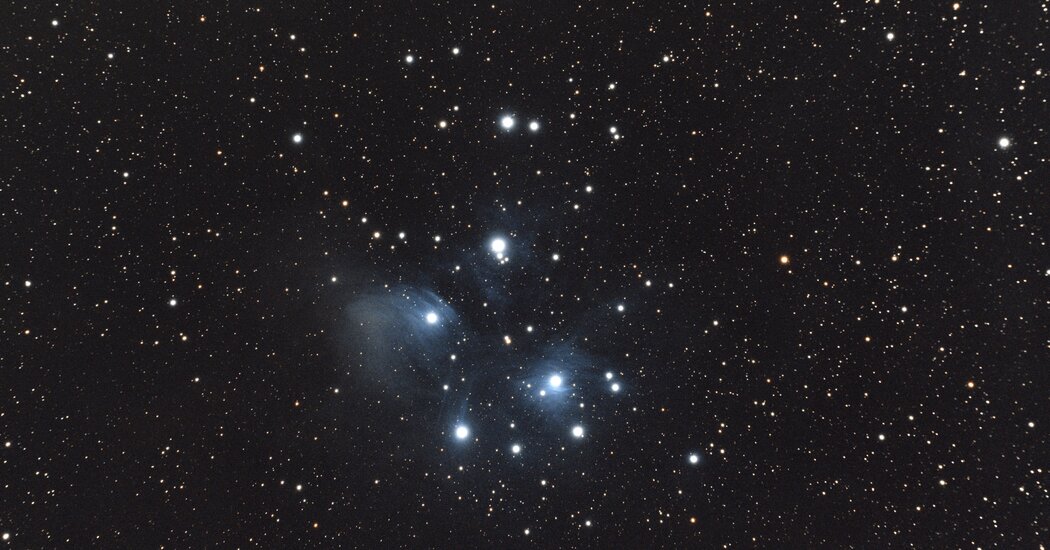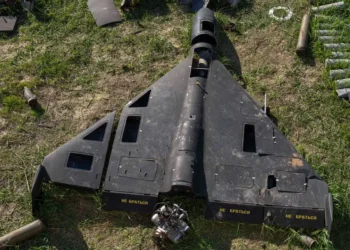Look to the east after sunset on a clear winter night and you’ll spot a bright, tightly packed collection of stars. That’s the Pleiades, a star cluster 445 light-years from Earth that has inspired both myth and measurement for centuries.
Only a handful of stars in the Pleiades, also known as the Seven Sisters, can be seen with the naked eye. But in a new paper, published in The Astrophysical Journal on Wednesday, astronomers announced that it comprises far more stars — upward of 3,000, if you could see them all — that together would span the entirety of the night sky.
In effect, what we call the Pleiades is merely the core of a larger, more diffuse network of stars, according to Andrew Boyle, a graduate student at the University of North Carolina at Chapel Hill who led the study. “They’re like sibling stars,” he said. “We identified thousands of these ‘lost sisters’ and reconstructed their shared origin.”
Cultures around the world have stories and traditions related to the Pleiades. In Greek mythology, the visible stars were once seven sisters, whom Zeus transformed to protect them from the hunter Orion. In Japan, the cluster, known as Subaru, inspired the logo for the car brand. The Māori people in New Zealand call it Matariki, and its rise in the winter sky marks the new year.
For professional astronomers, the Pleiades has been a benchmark for understanding the birth and evolution of stars and the planets that can form around them. Such studies may someday help astronomers determine if our own sun was born in a cluster, and where its lost siblings might be.
“Understanding the origins of our own solar system are part of this story,” said Luke Bouma, an astrophysicist at Carnegie Science in California who participated in the work.
Star clusters are groups of stars born together from the same giant cloud of gas and dust. Over millions of years, members of a cluster scatter throughout the galaxy, and the envelope of gas and dust is stripped away by stellar wind, radiation and supernovae until only the stars remain.
The Pleiades is undergoing that process now, Dr. Bouma said. Before the new study, 1,000 or so stars had been identified as belonging to the cluster, most too faint to be seen by eye. Astronomers have had difficulty tracking down more because of how spread apart they are in the sky.
Mr. Boyle and his colleagues began hunting for the Pleiades’s missing stars using stellar rotation data from NASA’s Transiting Exoplanet Survey Satellite. Stars spin slower as they grow older, so their rotation rate serves as a proxy for their age. The team first identified stars spinning at the rate expected of the Pleiades, which is thought to be about 100 million years old.
Using measurements from the European Space Agency’s Gaia satellite, which was retired earlier this year, the team traced the motions of these stars back in time, retaining only those that were once close to the Pleiades core. Data from the Sloan Digital Sky Survey, gathered by a ground telescope in New Mexico, helped to filter out stars that did not share the same abundance of elements, such as carbon and nitrogen, as known members of the cluster.
After assessing age, motion and chemistry, the astronomers were left with a list of 3,091 stars in what they named the Greater Pleiades Complex. The stars are spread across nearly 2,000-light years, many structured in bridges that connect back to the cluster’s core.
According to Mr. Boyle, their list is almost surely an underestimate. “I think there’s actually far more,” he said. The method developed by the team works best for stars with masses similar to that of our sun, so the list omits stars of insufficient mass. In fact the list does not even contain the original Seven Sisters, as they are too big and too hot — indicating the limits of their method, Mr. Boyle said, because “the physics of those stars is different.”
Jonathan Gagné, an astrophysicist at Rio Tinto Alcan Planetarium in Montreal who was not involved in the work, called the study “really solid,” adding that the discovery did not surprise him. In 2021, Dr. Gagné published a paper exploring possible relations between the Pleiades and a few other star systems. What the new study has done, Dr. Gagné said, “is add a bunch of others on top of that, and add more evidence that they are related.”
Going forward, Mr. Boyle’s team plans to trace the genealogy of other star clusters in our corner of the universe, to learn if other mega-structures exist and how they compare to the Greater Pleiades Complex.
Not long after the discovery, Mr. Boyle went stargazing in the mountains, and felt humbled as he caught the sight of the Pleiades high in the sky, just before dawn.
“If I could actually see everything that’s there, it’d just be this arc of stars that would stretch from horizon to horizon,” he said. “It shows that there’s a lot more out there that we can find.”
Katrina Miller is a science reporter for The Times based in Chicago. She earned a Ph.D. in physics from the University of Chicago.
The post The ‘Lost Sisters’ of the Pleiades Fill the Entire Night Sky appeared first on New York Times.




